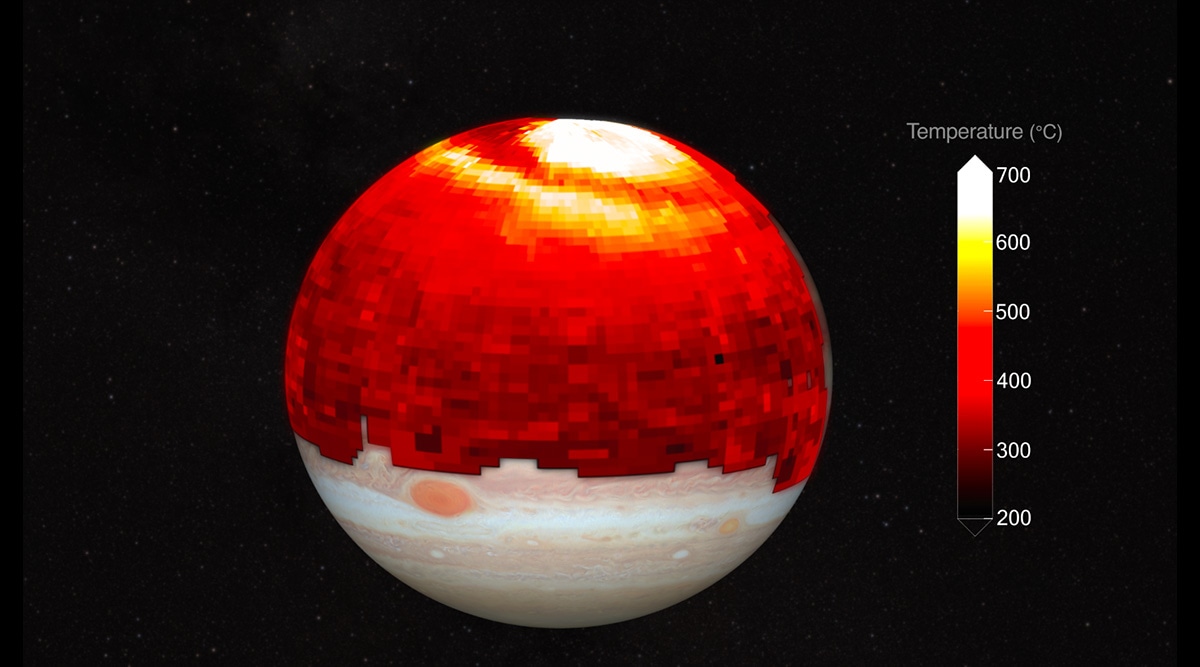With average temperatures hovering around minus 145 celsius, Jupiter is known for being a frigid planet. But JAXA (Japanese Aerospace Exploration Agency) scientists have discovered an unexpected 700 degrees Celsius “heat wave” that extends over 130,000 kilometres on the gas giant. The Earth’s diameter is approximately 12,742 kilometres.
To put that into context, the upper atmosphere of Jupiter should theoretically have a temperature of -70 degrees Celsius. Instead, scientists are measuring a cloud top temperature of over 400 degrees Celsius. This is incredibly hot for a planet that only receives 4 per cent of the sunlight that Earth does.
We discovered a huge 700°C heat-wave in Jupiter’s high atmosphere stretching over 130,000 km (10 Earths wide)! It was blasted out from the hot polar auroras toward the equator at 2,700 km/h, after dense solar winds impacted Jupiter. Presented at #EPSC2022 planetary conference! pic.twitter.com/KsPXI2fEua
— Dr James O’Donoghue (@physicsJ) September 23, 2022
“Last year we produced – and presented at EPSC2021 – the first maps of Jupiter’s upper atmosphere capable of identifying the dominant heat sources. Thanks to these maps, we demonstrated that Jupiter’s auroras were a possible mechanism that could explain these temperatures,” said James O’Donoghue of JAXA in a press statement. O’Donoghue presented the results of the research during the Europlanet Science Congress (EPSC) 2022 in Granada.
Jupiter experiences auroras around its poles as an effect of solar wind but unlike on Earth, where auroras only occur when solar activity is intense, Jupiter has permanent auroras. These auroras are what is heating the region around the poles to over 700 degrees Celsius. The global winds on the planet then redistribute the heat around Jupiter.
O’Donohogue and his team detected the heat wave just below the northern aurora and discovered that it was travelling towards the equator of the planet at speeds of thousands of kilometres per hour. It is likely that the heat wave was triggered by a pulse of enhanced solar wind impacting the planet’s magnetic field. This must have boosted auroral heating, forcing gases to expand and move towards the equator.
“While the auroras continuously deliver heat to the rest of the planet, these heat wave ‘events’ represent an additional, significant energy source. These findings add to our knowledge of Jupiter’s upper-atmospheric weather and climate, and are a great help in trying to solve the ‘energy crisis’ problem that plagues research into the giant planets,” added O’Donohogue.
!function(f,b,e,v,n,t,s)
{if(f.fbq)return;n=f.fbq=function(){n.callMethod?
n.callMethod.apply(n,arguments):n.queue.push(arguments)};
if(!f._fbq)f._fbq=n;n.push=n;n.loaded=!0;n.version=’2.0′;
n.queue=[];t=b.createElement(e);t.async=!0;
t.src=v;s=b.getElementsByTagName(e)[0];
s.parentNode.insertBefore(t,s)}(window, document,’script’,
‘https://connect.facebook.net/en_US/fbevents.js’);
fbq(‘init’, ‘444470064056909’);
fbq(‘track’, ‘PageView’);







